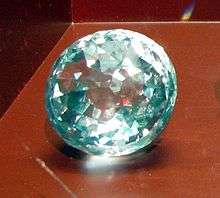Kollur Mine

The Kollur Mine (or Gani Coulour) in the Guntur district of the Indian state of Andhra Pradesh was one of the most productive diamond mines in the world and the first major diamond centre. It is situated on the south bank of the River Krishna. It operated between the 16th and mid-19th centuries.[1] In addition to the Kollur, the Paritala, Gollapally, Mallavally, Ramallakota, and Banganapally were extremely prolific mines in India during this period.[2] At the height of production, it was recorded that around 60,000 people mined the region, including men, women, and children of all ages.[3][4][5]
The famous diamond known as the "Tavernier Diamond" was purchased by Jean-Baptiste Tavernier from the Kollur mine in the mid-17th century.[6] The diamond was purchased from Tavernier by King Louis XIV of France but was stolen during the French Revolution; it is believed to have reappeared as the re-cut Hope Diamond.[7] The Indian mines were eventually depleted and the diamond centre shifted to Brazil, where a good amount of diamonds were discovered. Many of the most famous and notable diamonds were mined from these early Indian mines, including the Koh-i-Noor, the Regent Diamond, the Great Mogul (all from the Kollur); the Daria-i-Noor, the Orloff, the Dresden Green, and the Nassak Diamond.[8]
Notable diamonds

Some of the most famous diamonds mined in the Kollur mines are:
- The Great Mogul Diamond, 280 carats (56 g) cut, 787 carats (157.4 g) rough, - Lost after Nādir Shāh sacked Delhi
- The Pitt or Regent Diamond, 140 carats (28.0 g) - in the Apollo Gallery, Louvre Museum, Paris
- Nizām Diamond, 340 carats (68.0 g) - currently owned by the Government of India.
- The Orloff Diamond, 300 carats (60.0 g)
- Daryā-ye Nūr, 182 carats (36.4 g) - in the Iranian Crown
- The Golconda, 135 carats (27.0 g) - belonging to Dunklings Jewellers, Melbourne, Australia.
- Koh-i-Noor, 105.6 carats (21.12 g) (793 carats (158.6 g) rough, 186 carats (37.2 g) cut, further cut for Crown Jewels) - in the British Crown Jewels, London
- The Hope Diamond, 67 carats (13.4 g) - in the American Museum of Natural History, the Smithsonian Institution, Washington
- The Kolluru Diamond, 63 carats (12.6 g) - Purchased by Tavernier and present location unknown.
- Dresden Green Diamond, 41 carats (8.2 g) - "The New Green Vault" in the Staatliche Kunstsammlungen Dresden.
Notes
 Golconda Diamond Mines Map (left, with location of Kollur Mine)
Golconda Diamond Mines Map (left, with location of Kollur Mine) Golconda Diamond Mines Map (right)
Golconda Diamond Mines Map (right)
References
- ↑ Marshal, E. 1677. A description of the Diamond Mines as presented by the Right Honourable, the Earl Marshal of England to the Royal Society. Philosophical Transactions of Royal Society, Pages 910-917
- ↑ A Manual of the Geology of India: Economic geology, by V. Ball. 1881; Henry Benedict Medlicott, William Thomas Blanford, Valentine Ball, Frederick Richard Mallett; By Geological Survey of India, 1881, p. 16
- ↑ India Before Europe, C.E.B. Asher and C. Talbot, Cambridge University Press, 2006, ISBN 0-521-80904-5, p. 40
- ↑ A History of India, Hermann Kulke and Dietmar Rothermund, Edition: 3, Routledge, 1998, p. 160; ISBN 0-415-15482-0
- ↑ Deccan Heritage, H. K. Gupta, A. Parasher and D. Balasubramanian, Indian National Science Academy, 2000, p. 144, Orient Blackswan, ISBN 81-7371-285-9
- ↑ Travels in India by Jean-Baptiste Tavernier, Cambridge University Press, 2012
- ↑ The History of the Hope Diamond, Smithsonian Institution
- ↑ LARGE AND FAMOUS DIAMONDS
External links
![]() Media related to Kollur Mine at Wikimedia Commons
Media related to Kollur Mine at Wikimedia Commons
Coordinates: 16°42′10.41″N 80°1′53.23″E / 16.7028917°N 80.0314528°E